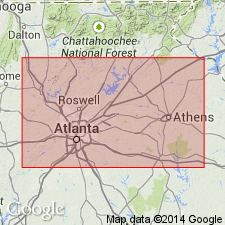
- Usage in publication:
-
- "migmatite of Kennesaw Mountain" of Hurst (1952)
- Modifications:
-
- Revised
- Overview
- AAPG geologic province:
-
- Piedmont-Blue Ridge province
Summary:
Used informally as migmatite of Kennesaw Mountain of the allochthonous assemblage. Hurst (1952, unpub. M.S. thesis) used the name "Kennesaw Mountain gneiss" for rocks he included in his migmatite category. McConnell and Abrams (1984) proposed formalized the name as Kennesaw Gneiss Member of their Laura Lake Mafic Complex. Usage is informal in this report because authors don't believe it belongs with Laura Lake Mafic Complex. Consists of light-gray to whitish-gray biotite-quartz-plagioclase gneiss that is identical to nearby metatrondhjemite gneisses except that it contains abundant xenoliths of amphibolite that are lithologically identical to amphibolite in Ropes Creek Metabasalt. Age of migmatite of Kennesaw Mountain of the allochthonous assemblage is changed to Late Proterozoic(?) to Middle Ordovician(?) based on a more conservative theory that the allochthonous rocks are 1) probably not older than Late Proterozoic because they are not part of Middle Proterozoic (Grenvillian) basement and 2) they could be as young, but not younger than, the time marking the beginning of closure of the ocean they originated in, as set by the slope reversal marked by deposition of Middle Ordovician Rockmart Slate upon unconformity at top of Upper Cambrian to Middle(?) Ordovician Knox Group and Middle Ordovician Lenoir Limestone. Report includes geologic map and correlation chart.
Source: GNU records (USGS DDS-6; Reston GNULEX).
For more information, please contact Nancy Stamm, Geologic Names Committee Secretary.
Asterisk (*) indicates published by U.S. Geological Survey authors.
"No current usage" (†) implies that a name has been abandoned or has fallen into disuse. Former usage and, if known, replacement name given in parentheses ( ).
Slash (/) indicates name conflicts with nomenclatural guidelines (CSN, 1933; ACSN, 1961, 1970; NACSN, 1983, 2005, 2021). May be explained within brackets ([ ]).

